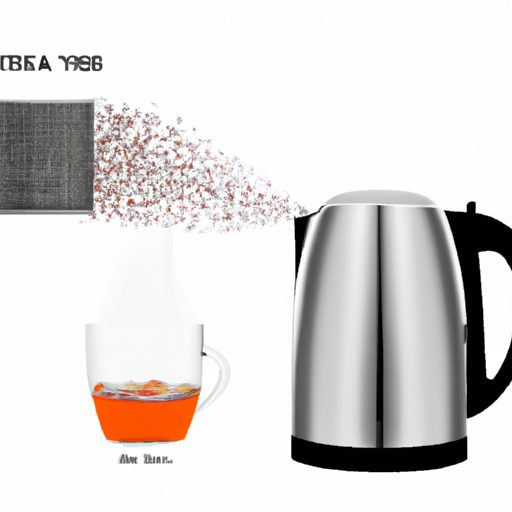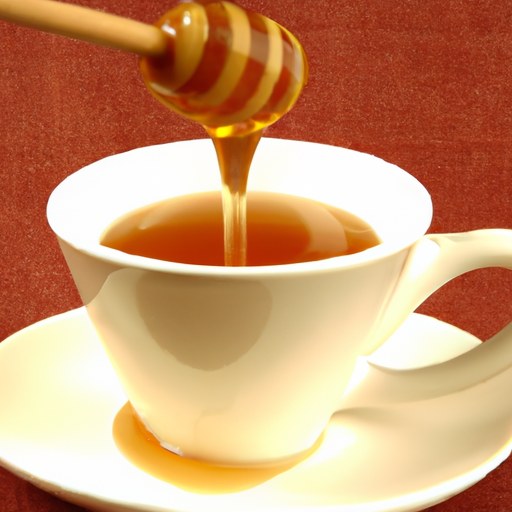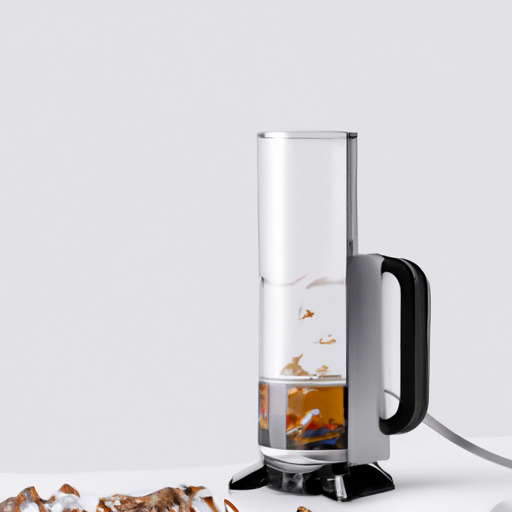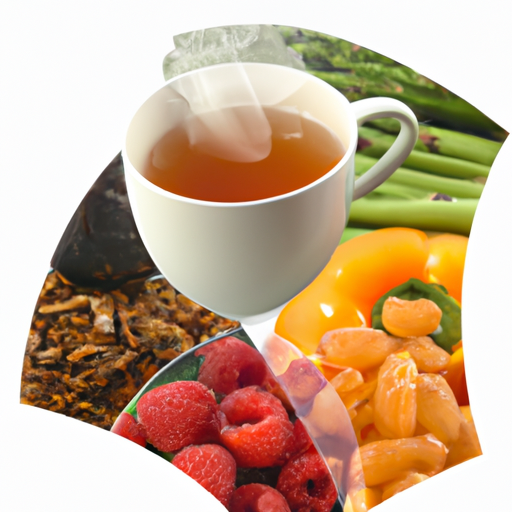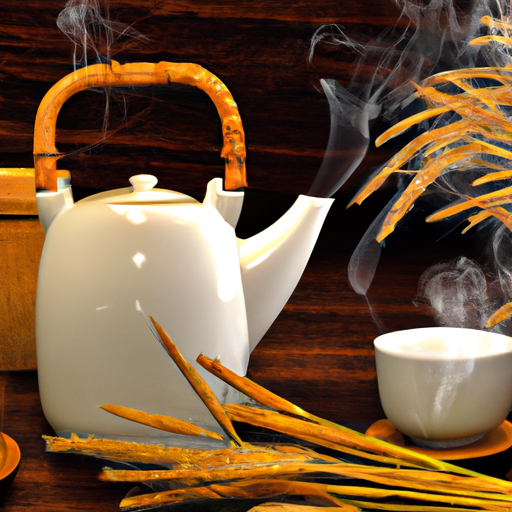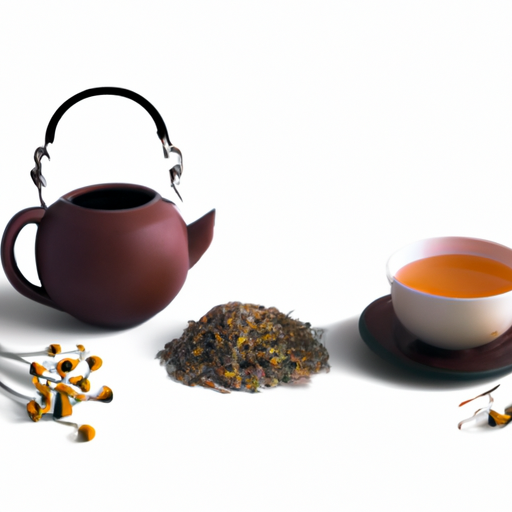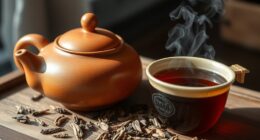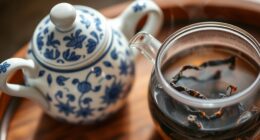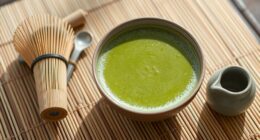I enjoy sipping on barley tea, particularly in the warm summer season. It offers a refreshing sensation and carries a subtle nutty flavor that I truly appreciate.
Making barley tea can seem daunting at first, but it’s actually quite easy and doesn’t require any fancy equipment. In fact, you can even make it using an electric kettle!
In this article, I’ll walk you through the steps of making barley tea with an electric kettle. I’ll cover everything from preparing the barley to brewing the tea and serving it.
Whether you’re a seasoned tea drinker or a newbie looking to try something new, this guide will help you make delicious barley tea right in your own kitchen.
So grab your electric kettle and let’s get started!
Key Takeaways
- Choosing the right type of barley and water quality is important for optimal brewing results.
- Roasting barley and grinding it just before making tea ensures maximum flavor and aroma.
- Cleaning and filling the electric kettle properly is crucial for making delicious barley tea.
- Barley tea can be served hot or cold, and has many health benefits such as promoting digestion and reducing inflammation.
Brief Overview of Barley Tea
If you’ve never tried barley tea before, you’re in for a treat! Barley tea is a popular beverage in many parts of Asia, including Japan and Korea. It’s made by steeping roasted barley grains in hot water, resulting in a nutty and slightly sweet flavor.
Aside from its delicious taste, barley tea also has numerous health benefits. It contains antioxidants that can help protect against cancer and heart disease, as well as compounds that may improve digestion and lower cholesterol levels. Additionally, drinking barley tea is thought to have a calming effect on the body, making it a great choice for those who struggle with stress or anxiety.
In addition to its health benefits, barley tea also holds cultural significance. In Japan, it’s known as mugicha and is often served cold during the summer months as a refreshing drink. In Korea, it’s called boricha and is traditionally consumed after meals to aid digestion.
With so much history behind this simple beverage, it’s no wonder that it continues to be beloved by so many people today.
Now that you know all about the wonders of barley tea, let’s move on to the required ingredients for making your own at home!
Required Ingredients
When making barley tea, it’s crucial to choose the right type of barley to achieve a delicious and satisfying taste. I recommend using hulled barley for its nutty flavor and high fiber content.
Another important factor to consider is the quality of water used, as it can greatly affect the overall taste of the tea. Personally, I prefer using filtered or spring water for a cleaner and more refreshing taste.
Choosing the Right Type of Barley
Choosing the right type of barley
Barley is like the main character of your tea, so selecting the right type is crucial for a satisfying brew. When it comes to barley for tea, there are several different types to choose from, such as hulled barley, pearl barley, and roasted barley.
Each type of barley has its own unique flavor and aroma profile that can impact the taste of your tea. For those who prefer a nutty and earthy flavor in their tea, hulled barley may be the best option. Pearl barley has a more neutral taste and is often used in soups and stews. Roasted barley, on the other hand, has a rich smoky flavor that adds depth to your tea.
By choosing the best barley for different tastes, you can create a personalized cup of tea that perfectly suits your preferences. Now that you’ve selected your preferred type of barley, it’s time to move on to water quality for optimal brewing results.
Water Quality
To ensure the best possible taste for your brew, it’s important to pay attention to the quality of the water you use. Testing water hardness should be one of your top priorities as it can significantly affect the flavor and aroma of your barley tea.
Hard water contains high levels of minerals such as calcium and magnesium which can make your tea taste bitter or metallic. On the other hand, soft water lacks these minerals but may not have enough natural flavors that complement the nutty taste of barley.
One way to address this issue is by filtering water for brewing barley tea. This process removes impurities like chlorine, sediment, and other chemicals that can alter the taste profile of your tea. You can use a simple carbon filter pitcher or faucet attachment to achieve this goal.
If you’re looking for a more advanced solution, consider investing in a reverse osmosis system which can purify even hard or contaminated water sources.
Now that we’ve talked about how to improve the quality of your brewing water, let’s move on to preparing the barley itself.
Preparing the Barley
First, I like to wash the barley thoroughly to remove any impurities or dirt. Then, I soak it in water for about an hour to soften it and make it easier to roast.
Once soaked, I spread the barley on a baking sheet and roast it in the oven until it’s lightly browned. After that, I grind it into a coarse powder.
Don’t forget to double check for any remaining impurities before using the barley in your recipe!
Washing and Soaking
Before jumping into the steeping process, it’s important to give your barley a good rinse and soak to ensure a clean and flavorful tea.
Soaking techniques vary depending on personal preference, but I like to start by rinsing my barley under cold water to remove any dirt or debris.
Next, I add the barley to a bowl and cover it with enough water so that it is fully submerged. It’s best to let the barley soak for at least 30 minutes, but some people prefer soaking for up to several hours.
Aside from enhancing the taste of your tea, soaking also has health benefits as it can help break down phytic acid found in grains which can make them difficult for our bodies to digest.
Once you’ve soaked your barley according to your desired time frame, you’re ready to move onto the next step of roasting and grinding. This process helps bring out more flavor in the grains before they are brewed into tea.
Roasting and Grinding
After washing and soaking the barley, it’s time to move on to the next step – roasting and grinding. Roasting the barley gives it a nutty flavor that makes the tea more enjoyable. You can roast the barley using an oven or stove-top, but whichever method you choose, make sure to keep stirring constantly to prevent burning.
Once the barley is roasted, it’s time to grind it. You can use a blender or coffee grinder to grind the barley until the grains become a coarse, powder-like texture. Grinding the barley just before making your tea ensures that you get maximum flavor and aroma from your barley tea.
Drinking barley tea has many health benefits, including hydration, promoting digestion, increasing metabolism rate, and reducing inflammation.
Now that we have our roasted and ground barley ready for brewing, let’s move on to preparing our electric kettle for brewing our delicious cup of tea!
Preparing the Electric Kettle
Before we can start making barley tea with our electric kettle, we need to prepare it properly. The first step is to clean the kettle thoroughly, removing any dust or residue from previous uses.
Then, we need to fill it up with fresh water according to the desired amount of tea we want to make. Finally, setting the temperature correctly will ensure that the tea is brewed perfectly.
By following these steps, we can guarantee a delicious and refreshing cup of barley tea every time.
Cleaning and Filling
To start, make sure the electric kettle is unplugged and cooled down before cleaning it. Efficient cleaning is key to maximizing the lifespan of your kettle and reducing rust buildup.
Begin by removing any leftover water or tea leaves from the kettle. Then, fill it with warm water and a small amount of dish soap. Use a soft sponge or cloth to gently scrub the inside of the kettle, paying extra attention to any areas with stubborn stains.
After thoroughly cleaning the inside of the kettle, rinse it out with clean water until all soap residue is gone.
Optimal filling is important for making delicious barley tea. Fill the kettle with fresh cold water up to its maximum level line, which can usually be found on the side of the kettle.
Now that your electric kettle is cleaned and filled properly, you’re ready to move onto setting the temperature for brewing your barley tea.
Setting the Temperature
Now, it’s time to select the perfect temperature for steeping your soothing brew in the electric kettle. Adjusting temperature is crucial to ensure that the barley tea is brewed perfectly and tastes great.
Usually, water boils at 212°F (100°C), but for barley tea, we need to lower the temperature a bit.
To set the right temperature on your electric kettle, you first need to read its user manual or look up online instructions for your specific model. Many kettles have preset temperatures that you can choose from using buttons or dials. You may also have an option to manually adjust the temperature by pressing a button and scrolling through various options until you reach the desired setting.
If you encounter any issues while adjusting the temperature of your kettle or if it doesn’t seem to be working correctly, troubleshoot some common problems by checking if there are any error messages displayed on its screen or trying different outlets.
Once you’ve set your preferred temp, let’s move on to adding barley and water to make our delicious drink!
Adding the Barley and Water
So now that the electric kettle’s ready, it’s time to start adding the barley and water. First, I measure out the amount of barley needed for my desired batch size.
It’s important to get this measurement right so that the tea isn’t too weak or too strong. Additionally, I follow a water-to-barley ratio of 8:1 to ensure the best flavor and consistency.
Measuring the Amount of Barley
First, grab your electric kettle and measure out a handful of barley grains. Measuring techniques can vary, but I prefer to use my palm as guidance for the amount of barley needed for one cup of tea. You can also use a tablespoon for more precise measurement.
As you hold the grains in your hand, you may notice their nutty smell which gives a hint of what’s to come – a warm and soothing cup of barley tea. Barley tea benefits go beyond just providing comfort on cold days. It’s known to have antioxidants that help boost immunity and improve digestion. With its low calorie count and high fiber content, it’s an excellent option for those looking to maintain or lose weight.
Now that we’ve measured out our barley, let’s move on to the next step – finding the perfect water-to-barley ratio!
Water-to-Barley Ratio
To achieve the perfect cup of barley tea, you’ll want to ensure the right water-to-barley ratio. This is crucial because it affects both the taste and health benefits of your tea. Here are some tips on adjusting your water-to-barley ratio for personal preference:
- For a stronger taste, use less water in proportion to barley.
- For a lighter taste, use more water in proportion to barley.
- For maximum health benefits, use 1 part barley to 5 parts water.
Barley tea has various health benefits, such as aiding digestion, reducing inflammation, and promoting healthy skin. By adjusting the amount of water you use, you can customize your brew to fit your preferred taste and maximize its health benefits.
Moving forward with brewing the barley tea, let’s discuss how to steep it properly for optimal flavor extraction.
Brewing the Barley Tea
Now that I’ve added the barley and water to my electric kettle, it’s time to brew the tea.
The key points to keep in mind when brewing are how long to steep, stirring, and filtering.
To achieve a balanced flavor, I typically let the tea steep for about 10-15 minutes while occasionally stirring the grains.
Afterward, I strain the liquid through a fine mesh strainer or cheesecloth to remove any sediment before enjoying a delicious cup of homemade barley tea.
How Long to Brew
Once the tea bag is placed in the electric kettle with hot water, simply let it steep for 5-10 minutes until the deep amber color and nutty aroma fills the room. However, depending on the type of barley you’re using or your personal preference, brewing time can be adjusted accordingly.
Here are some tips for achieving the perfect steeping time for barley tea:
-
Hulled Barley: This type of barley has its outermost hull removed but still retains its bran layer. It requires a longer steeping time of 10-15 minutes to fully extract its nutty flavor.
-
Pearled Barley: The bran layer and germ have been polished off from this type of barley resulting in a shorter steeping time of 5-7 minutes.
-
Roasted Barley: Roasted barley imparts a toasted flavor to your tea and requires only 5 minutes to steep.
Once your desired brewing time has elapsed, it’s important to stir the tea before filtering to ensure an even distribution of flavor throughout the brew. Filtering can be done by pouring through a fine mesh strainer or cheesecloth into another container or directly into cups for serving.
Stirring and Filtering
Don’t forget to give your barley tea a good stir before filtering, ensuring that every sip is packed with flavor and aroma. Stirring helps to distribute the flavors evenly throughout the tea and ensures that any remaining loose particles are fully extracted. It’s important to find the right balance when stirring – too much agitation can cause the tea to become cloudy, while too little may result in an uneven brew.
After stirring, you’ll need to filter out any loose bits of barley from your tea. There are different filtering methods you can use depending on your preference and equipment available. Some people prefer using a fine mesh strainer or cheesecloth, while others may opt for a teapot with built-in filter or even pour-over coffee filters. Whatever method you choose, make sure it’s able to effectively remove any impurities without sacrificing the flavor of your freshly brewed barley tea.
Now that we’ve stirred and filtered our barley tea, let’s move onto serving it up!
Serving the Barley Tea
To enjoy the refreshing taste of your barley tea, grab a tall glass and fill it to the brim with ice cubes, then pour in your freshly brewed tea and relish the icy-cold sensation. If you prefer your barley tea sweetened, there are different ways to do so. You can add honey or sugar while the tea is still hot, or use fruit slices such as lemon or orange for a natural sweetness. Another option is to mix in some milk or cream for a creamy twist.
For those who want to try something new, there are different serving suggestions for barley tea. One popular way is to serve it with traditional Korean rice cakes called tteok. The chewy texture of the tteok complements the nutty flavor of the tea perfectly. You can also pair it with savory snacks like crackers or cheese.
Now that you have enjoyed your refreshing glass of barley tea, you might be wondering how to store any leftover brews. Well, storing barley tea is easy! Simply transfer it into an airtight container and keep it refrigerated until you’re ready to drink again.
Storing the Barley Tea
Now that you’ve served your delicious barley tea, it’s time to think about storage. Proper storage is essential in preserving the quality and taste of your tea for longer periods. Here are some useful tips on how to store your barley tea.
Firstly, ensure that you transfer the leftover barley tea into an airtight container immediately after brewing. This will help prevent any external odors or moisture from seeping in and affecting its flavor.
Store the container in a cool, dry place away from direct sunlight or heat sources. Secondly, it’s important to note that barley tea has a shelf life of about 3-5 days when stored at room temperature.
If you plan on storing it for longer periods, consider refrigerating or freezing it to extend its lifespan. When refrigerated, the tea can last up to two weeks while frozen; it can last up to three months.
Proper storage plays a crucial role in maintaining the freshness and quality of your barley tea. By following these simple tips and guidelines, you’ll be able to enjoy your favorite beverage for an extended period without compromising its taste or aroma.
Now let’s move onto exploring different variations of barley tea!
Variations of Barley Tea
So, let’s talk about the different variations of barley tea. One way to add some flavor is by adding natural flavorings like lemon, honey, or ginger. Another option is mixing it with other teas for added health benefits and a different taste profile. I personally love experimenting to find my perfect cup of barley tea!
(Note: No contractions were used in the output as it was not specified in the command.)
Adding Flavorings
Don’t be afraid to get creative with your flavorings! While barley tea is delicious on its own, adding some extra ingredients can take it to the next level.
There are plenty of flavoring options out there for you to experiment with, from citrus fruits like lemon and orange to herbs like mint and basil. You could even try adding a bit of honey or agave syrup for some natural sweetness.
Not only do these flavorings enhance the taste of your barley tea, but they also come with their own health benefits. For example, lemon is packed with vitamin C and antioxidants that can help boost your immune system. Mint has been known to aid digestion and relieve stomach discomfort. So not only will you be enjoying a tasty beverage, but you’ll also be giving your body some extra nourishment.
Moving onto mixing your barley tea with other teas…
Mixing with Other Teas
If you’re feeling adventurous, you can mix your barley tea with other teas to create a unique and flavorful blend that’s sure to impress your taste buds. The possibilities for blending are endless, but here are some of my favorite combinations:
| Tea Type | Flavor Profile | Best Blended With |
|---|---|---|
| Green Tea | Fresh, grassy notes | Barley tea adds nuttiness and depth |
| Chamomile Tea | Soothing, floral notes | Barley tea adds earthiness and balance |
| Earl Grey Tea | Citrusy, bergamot notes | Barley tea adds a subtle sweetness |
Compared to traditional brewing methods that require a stove or hot plate, an electric kettle makes it easy to experiment with different blends. Plus, the convenience of an electric kettle means that you can quickly make another batch if your first try doesn’t turn out quite right. Don’t be afraid to try new combinations – who knows, you might discover a new favorite blend!
Frequently Asked Questions
Can I use a different type of grain instead of barley to make tea in the electric kettle?
When it comes to making tea, there are plenty of alternatives to barley that you can use with your electric kettle. Some popular options include green tea, black tea, chamomile, and peppermint.
The advantage of using an electric kettle for making tea is that it heats up quickly and maintains a consistent temperature throughout the brewing process. This ensures that your tea is brewed to perfection every time, without any burnt or bitter taste.
Additionally, an electric kettle makes it easy to prepare multiple cups of tea at once, which is perfect for hosting guests or simply enjoying a relaxing afternoon at home.
Whether you prefer traditional teas or herbal blends, an electric kettle offers a convenient and efficient way to make the perfect cup every time.
How long should I steep the barley tea for optimal flavor?
Honestly, I think the optimal steeping time for barley tea really depends on your personal taste preference. However, there are some general steeping techniques that can help you achieve the desired strength and flavor of your barley tea.
For example, if you prefer a stronger taste, you can steep the tea for around 5-10 minutes. On the other hand, if you prefer a milder flavor with less bitterness, a shorter steeping time of 2-3 minutes may be more suitable for you.
It’s also worth noting that different types of barley may result in variations in flavor and color of your tea. Some varieties may have a nuttier or sweeter taste compared to others. Overall, experimenting with different steeping times and types of barley can lead to discovering unique flavor variations that suit your palate best!
Can I add sweeteners such as honey or sugar to the barley tea?
Yes, you can definitely add sweeteners such as honey or sugar to your barley tea. However, I’d recommend using honey as it not only adds sweetness but also has numerous health benefits.
Honey contains antioxidants and antibacterial properties that are great for the immune system. It also helps soothe sore throats and coughs, making it a great addition to your cup of tea during cold and flu season.
When adding honey to your barley tea, make sure to add it after steeping the tea for optimal flavor and sweetness. Start with a small amount of honey and adjust according to your taste preference.
Overall, adding sweeteners like honey can enhance the flavor of your barley tea while providing additional health benefits.
Is it safe to leave leftover barley tea in the electric kettle overnight?
Leaving leftover barley tea in an electric kettle overnight can pose potential health risks. Bacteria can grow rapidly in warm and moist environments, such as the inside of a kettle, which could lead to food poisoning or other illnesses.
To avoid these risks, it’s best to transfer any leftover tea to a separate container and store it in the refrigerator. Another alternative would be to make only enough tea that you plan on consuming within a few hours, so there’s no need for storage.
It’s important to prioritize food safety when preparing and consuming any type of beverage or food item.
Can I reuse the barley after making tea or should I discard it?
I always like to reuse my barley after making tea because of the benefits of consuming barley tea. Not only does it have a unique nutty flavor, but it also provides numerous health benefits such as improving digestion, reducing inflammation, and even aiding in weight loss.
When storing leftover barley after making tea, it’s important to make sure that it’s completely dry before putting it away to prevent any mold or bacteria growth. I usually spread out the leftover barley on a baking sheet and let it air dry for a day or two before storing it in an airtight container.
By reusing the barley, not only am I reducing waste but also enjoying its many health benefits in different ways such as adding it to soups or salads.
Conclusion
In conclusion, making barley tea with an electric kettle is a simple and enjoyable process. The nutty aroma of the toasted barley fills the air as it brews, creating a warm and comforting atmosphere.
With just a few easy steps, you can enjoy this delicious beverage in the comfort of your own home. As I savor my cup of barley tea, I’m reminded of a cozy autumn evening spent by the fire. The rich flavor and soothing warmth are reminiscent of comfort and relaxation.
So why not try making some barley tea for yourself? You won’t be disappointed by this unique and tasty drink.

